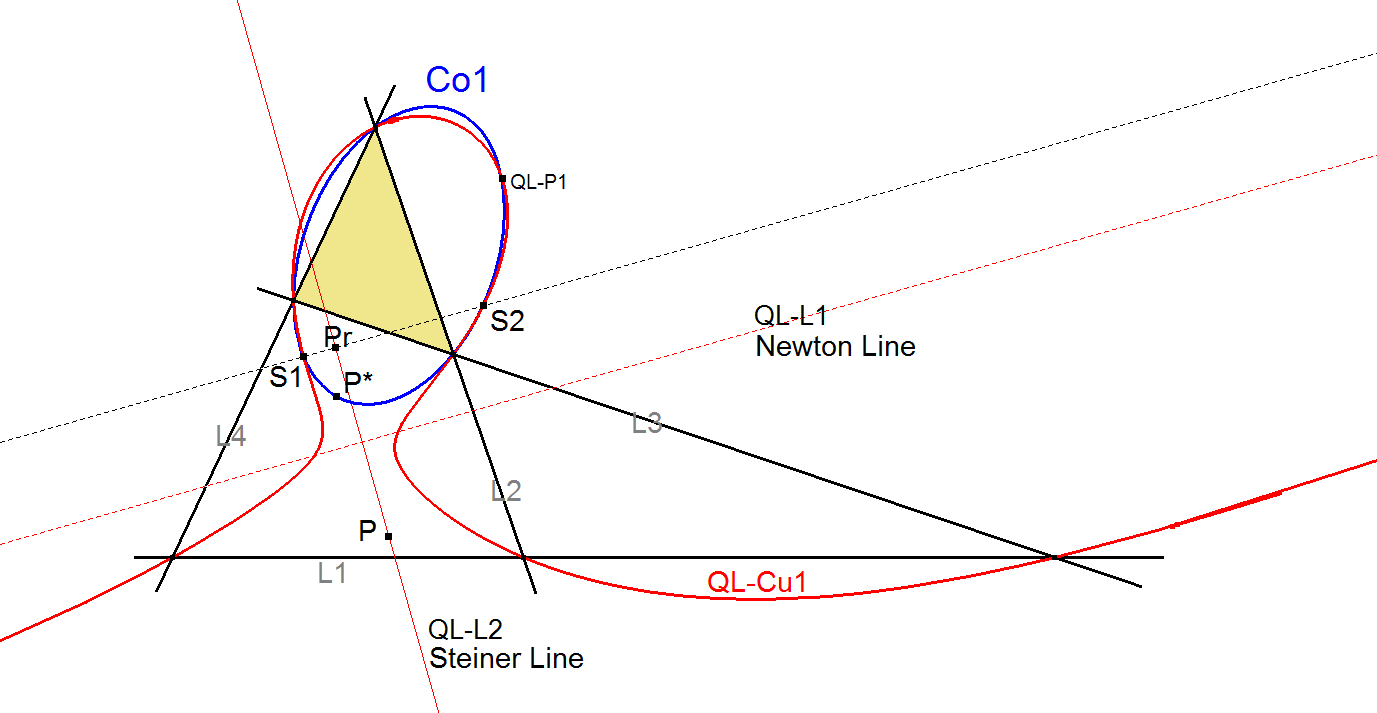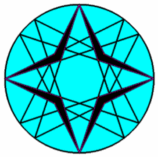QL-Cu1: QL-Quasi Isogonal Cubic
QL-Cu1 has several special characteristics:
- QL-Cu1 is the locus of all points P for which the Isogonal Conjugates wrt all 4 component triangles coincide in a point on the same cubic. So the cubic is in terms of a quadrilateral QL-self-isogonal.
- QL-Cu1 is the locus of all points P for which the QG-Quasi Isogonal Conjugates wrt all 3 component quadrigons coincide in a point on the same cubic.
- QL-Cu1 is the locus of the foci of all inscribed conics in the Reference Quadrilateral.
- QL-Cu1 is the locus of all points for whom the Midpoint of this point and its Clawson-Schmidt Conjugate lie on the Newton Line QL-L1.
- QL-Cu1 is the locus of all points P for which the reflections of P in the 4 quadrilateral lines are concyclic (Seiichi Kirikami in [34], EQF message #1093).
- QL-Cu1 is the locus of all points P for which the feet of the perpendiculars from P to the 4 quadrilateral lines are concyclic (all lie on a circle).
- QL-Cu1 is the locus of points, whose Antipedal Quadrigon is cyclic (if not degenerated) (see [34] message #355 from Eckart Schmidt).
- QL-Cu1 is the locus of all points P where all perpendiculars from Li^Lj at Si.Sj coincide in a point on the same cubic, where Si = pedal point of P on Li.
- QL-Cu1 is the locus of points, whose reflections in the circumcircles of the QL-Component Triangles are concyclic (Eckart Schmidt in [34], EQF message #403).
- If the Reference System is the Reference Quadrilateral, this cubic is a circular isocubic invariant to the Clawson-Schmidt Conjugate QL-Tf1.
If the Reference System is the Orthic Triangle of the QL-Diagonal Triangle, this cubic is an isogonal circular cubic.
This Quadrilateral Cubic is also described (with other names) by Fred Lang (see [24] page 3) and Eckart Schmidt (see [15e]).
More information about the type of cubic is described by Bernard Gibert at [17b] and [17d].
More information about the subject also can be found at [43].

How to draw a line through all 6 points of a Quadrilateral . . .
Construction
- Let P be some point on QL-L2 (Steiner Line).
- P* = Isogonal Conjugate of P wrt Triangle L2.L3.L4 (or any other QL-Component Triangle).
- Co1= Conic through vertices triangle L2.L3.L4 and QL-P1 and P*.
- Pr = P reflected in QL-L1 (Newton Line).
- Lr = line through Pr // QL-L1 (now P is railway watcher).
- S1 and S2 are intersection points Lr ^ Co1.
QL-Cu1 is the locus of S1and S2 with variable P on QL-L2 (Steiner Line).
For other properties regarding QL-Cu1 see [34], QFG # 193 and # 194.
Conjugates on QL-Cu1
The Clawson-Schmidt Conjugate (QL-Tf1) is very important on QL-Cu1.
It is very special that this conjugate has the same performance for points on QL-Cu1as:
- the Isogonal Conjugate of P wrt the Orthic Triangle of the QL-Diagonal Triangle (note Eckart Schmidt).
- the Quasi Isogonal Conjugate (QG-Tf2) of P wrt any Quadrigon of the Reference Quadrilateral (note Eckart Schmidt).
Other properties of this conjugate:
- Conjugated pairs of points on QL-Cu1 lie at different sides of the Newton line at equal distances.
- The tangents of a pair of conjugated points on QL-Cu1 will intersect in another point at QL-Cu1 (see [34], QFG # 185).
Easy construction method of Clawson-Schmidt conjugated points on QL-Cu1
Any point X on QL-Cu1 can be seen as the intersection point of the line Ln parallel to the Newton line and the connecting line Lp=QL-P1.X.
Now CSC(X) can be constructed as the intersection point of La’ and Lb’, where:
Ln’ = Ln Reflected in the Newton Line
Lp’ = Lp reflected in the 1st Steiner Axis (see description at QL-Tf1)
1st Steiner Axis
The 1st Steiner Axis easily can be constructed as:
- an internal angle bisector of Sij.QL-P1.Skl, where Sij=Li^Lj, Skl=Lk^Ll for all (i,j,k,l) ∈ (1,2,3,4), or
- the internal angle bisector if QL-2P2a.QL-P1.QL-2P2b, where QL-2P2a and QL-2P2b are the two points on the Newton Line that are mutually conjugated.
As a consequence, when X1 and X2 are CS-conjugated points, then the line through X1 parallel to QL-L1 and the line X2.QL-P1 will cross in another point on QL-Cu1. X1 and X2 can be interchanged here.
Two interesting new points on QL-Cu1
- S = the intersection point of the asymptote and line QL-P1.QL-P4.
- T = the intersection point of the perpendicular bisector of QL-2P2a/b and the line through QL-P1 parallel to QL-L1.
- S and T are Clawson-Schmidt Conjugated,
- and so the intersection point of their tangents at QL-Cu1 also lies at QL-Cu1.
Tangents to QL-Cu1
- The tangent at QL-Cu1 in QL-P1 = QL-P1.QL-P4.
- This line is also tangent in QL-P1 at the circle (QL-P1,QL-2P2a,QL-2P2b), which is the Clawson-Schmidt Conjugate (QL-Tf1) of the Newton Line QL-L1.
- The tangent at QL-Cu1 in T is S.T reflected in the perpendicular bisector of line segment QL-2P2a.QL-2P2b.
General construction method of the tangent in a point P on QL-Cu1
(method Eckart Schmidt, see [15e] and [34], QFG # 194)
- Let P* be the isogonal conjugate of P
- and Co1 the isogonal conjugate of PP* wrt the triangle L1,L2,L3
- and Co2 the isogonal conjugate of PP* wrt the triangle L2,L3,L4.
- Let Q be the 4th intersection of Co1 and Co 2.
- Then PQ is the tangent in P wrt QL-Cu1.
Equation in CT-notation
a2 l (m y + n z) y z + b2 m (n z + l x) x z + c2 n (l x + m y) x y + 2 (SA m n + SB l n + SC l m) x y z = 0
CT-coordinates Infinity Point Asymptote
( l (m – n) : m (n – l) : n (l – m) )
Equation in DT-notation
l2 x2 (SA x – SB y – SC z)– m2 y2 (SA x – SB y + SC z) – n2 z2 (SA x + SB y – SC z)
– (a2 l2 + b2 m2 + c2 n2) x y z = 0
DT-coordinates Infinity Point Asymptote
( m2 – n2 : n2 – l2 : l2 – m2 )
Properties
- These points lie on QL-Cu1:
- all 6 intersection points of the 4 lines of the Reference Quadrilateral
- QL-P1: the Miquel Point
- QG-P17a/b/c: the vertices of the Orthic Triangle of the QL-Diagonal Triangle
- QG-P18a/b/c: the 3 QL-versions of QG-P18
- the 3 QL-versions of QG-2P5a and QG-2P5b: the intersection points of QG-Ci2 with the QG-Diagonals
- there are exactly 2 points on the Newton Line that are each other’s Isogonal Conjugate wrt all 4 QL-Component Triangles. Both points lie on QL-Cu1. See [34], QFG # 179.
- The Trilinear Poles of Li wrt triangle Lj.Lk.Ll, where (i,j,k,l) ∈ (1,2,3,4).
- the intersection point S of the asymptote and line QL-P1.QL-P4.
- the intersection point T of the perpendicular bisector of line segment QL-2P2a.QL-2P2b and the line parallel to QL-L1 through QL-P1.
- (S and T are a QL-Tf1-conjugated pair of points)
- the circular points at infinity (so the cubic is called circular, see [17c])
- The tangents at the circular points at infinity meet at the Miquel Point QL – P1. This point also lies on QL-Cu1, which makes this cubic a Van Rees Cubic / Focal Cubic. See [17c].
- The line QL-P1.QL-P4 is tangent at QL-Cu1 in QL-P1.
- The asymptote of QL-Cu1 // QL-L1 = Newton Line.
- Distance Miquel Point (QL-P1) to Asymptote is twice the distance from Miquel Point to Newton Line (Railway Watcher system, see QL-L-1).
- QL-P21 lies on the asymptote of QL-Cu1.
- The Clawson-Schmidt Conjugate (QL-Tf1) of some point P on the cubic is also a point on the cubic. Thus the cubic is invariant under Clawson-Schmidt-conjugation. See [15e].
- The Clawson-Schmidt Conjugate (QL-Tf1) of some point P on QL-Cu1 is identical with the Isogonal Conjugate of P wrt the Orthic Triangle of the QL-Diagonal Triangle (note Eckart Schmidt).
- The Clawson-Schmidt Conjugate (QL-Tf1) of some point P on QL-Cu1 is identical with the Quasi Isogonal Conjugate (QG-Tf2) of P wrt any Quadrigon of the Reference Quadrilateral (note Eckart Schmidt).
- QL-Cu1 is the locus of intersection points of QG-Tf2(L) and QL-Tf1(L), where L = variable line through QG-P1 (Eckart Schmidt in [34], EQF message #224).
- The circle through QL-2P2a & QL-2P2b and QL-P1 is the QL-Tf1 image of the Newton Line QL-L1 and is tangent at QL-Cu1 in QL-P1. The common tangent at QL-P1 is the line QL-P1.QL-P4.
- Let X be a variable point on the Newton Line QL-L1, then the intersections of the angle bisector of QL-2P3a . X . QL-2P3b and its QL-Tf1 image (a circle through QL-P1) are points of QL-Cu1 (Eckart Schmidt in [34], EQF message #403).
- Let P1P2P3P4 be a quadrigon: For points X on QL-Cu1 the centers of the circumcircles for P1XP2, P2XP3, P3XP4, P4XP1 are concyclic. (Eckart Schmidt in [34], EQF message #426).
- QL-Cu1 is the locus for points whose angle bisectors wrt two opposite vertices of the Reference Quadrilateral are QL-Tf2 partners.
- For any fixed point X on QL-Cu1, for any pair of variable QL-Tf1 conjugate points Y and Y’ (including obviously the opposite vertices of the QL), the direction of the bisectors of the angle YXY’ is the same (Eckart Schmidt, Bernard Keizer, see [34], QFG#1206, #1207).
- Let A, B, C, QL-P1 be concyclic points on QL-Cu1, then QL-Cu1 is invariant wrt the ABC-isogonal conjugate (Eckart Schmidt [34], QFG#1399).
Estimated human page views: 1082
